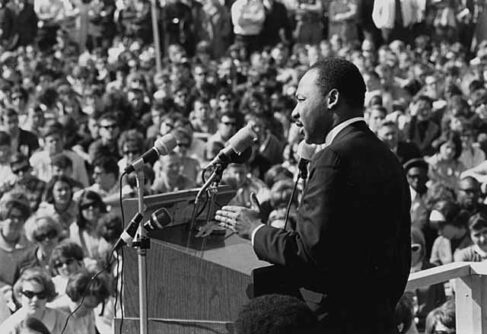This New York Times special section is an encomium for progressive, systemic, big-scale philanthropy. But, curiously, it is in sharp contrast with an older, small-scale approach to philanthropy that the Times used to represent…
This past Sunday’s New York Times included a special section titled “Giving” that showcases a certain elite view of philanthropy as a big-scale, progressive enterprise. The front page says it all:
No more small ball: Now the big foundations are going for systemic change, taking on hot-button (and progressive) issues like inequality, injustice and global warming.
The lead article, “Foundations Aim High” is set against a graphic with a globe surrounded by an archer’s arrow, suggesting that there’s nothing on Earth not encompassed by today’s big-scale philanthropy. And it describes, in glowing terms, the “renewed sense of philanthropic ambition,” as well as the “big bets” made by the largest foundations, including the Ford Foundation, the Gates Foundation, and the MacArthur Foundation, on issues such as climate change, criminal justice, and relieving inequality.
Turning to the second page of this special section, one finds an article about how an organization’s stance on sexual identity issues can impact its fundraising efforts. The article pairs an account of how the Girl Scouts of Western Washington experienced a fund-raising boom after turning down a $100,000 gift from a donor who didn’t want to support transgender students with an account of criticism of Gordon College asking for an exemption from an anticipated federal order barring discrimination in hiring based on sexual orientation. Although the Times (grudgingly?) reports that Gordon College had a good fundraising year regardless in spite of the criticism it received, the clear message of the article is that there’s little point in donors trying to swim against the tide of the large-scale social change we’ve seen on this issue.
The special second also includes a flattering profile, titled “Billionaire as Catalyst,” of Microsoft co-founder Paul Allen, which is accompanied by a large photo of him in his majestic home. The article recounts how he draws upon his business expertise to aim at “big breakthroughs that will transform society.”
And, yes, to be fair, on the last page of the special section, there’s an article about philanthropy on a small scale: an article about a couple who established a pit bull rescue group. As though there had to be a token acknowledgement of philanthropists who are aiming to change only their neighborhood, not the world.
(Throughout the special section, this ambitious philanthropy based on a business model is described as a new phenomenon. But, in fact, this is just another case of everything old being new again. American Philanthropic Jeremy Beer’s new book, The Philanthropic Revolution: An Alternative Version of American Charity, chronicles how these same ambitions were shared by the big nineteenth century industrialists like Andrew Carnegie.)
This New York Times special section is an encomium for progressive, systemic, big-scale philanthropy, and it tells us much about the views of the New York Times editorial board and its readership today. But, curiously, it is in sharp contrast with an older, small-scale approach to philanthropy that the New York Times embodied by its Neediest Cases Fund. The Neediest Cases Fund was launched in 1912 by Adolph S. Ochs, then-publisher of the Times, after a Christmas Day encounter with a poor man than inspired Ochs to focus philanthropy on destitute New Yorkers. Readers of the paper are invited to make donations, even of quite small amounts. Recipients are picked as individuals, and the support they are given is often quite small (in the terms of most people, not for the recipients!). And yet these small gifts have a great impact on the lives of New Yorkers, as is easy to read in the cases, often very moving, featured in the Times. This kind of small-scale, non-systemic, local philanthropy spurned by so many today deserves appreciation for its crucial role in American society.






